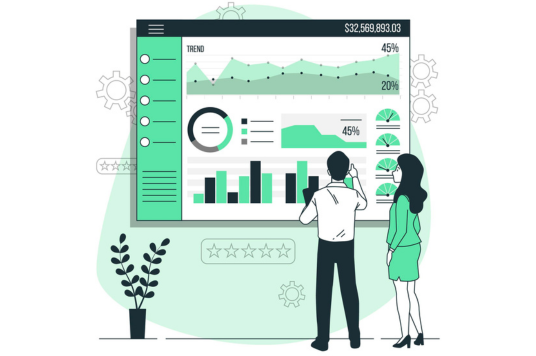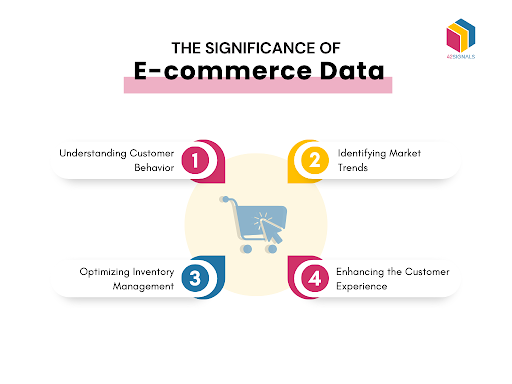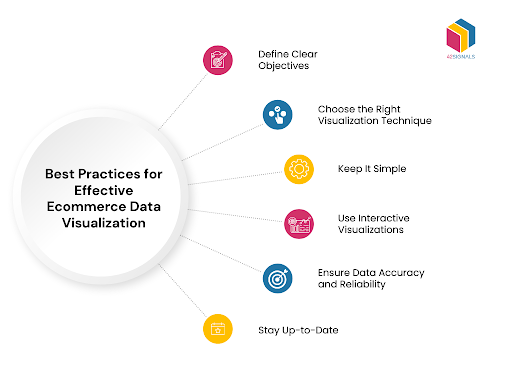As online shopping continues its rapid expansion, businesses are inundated with an abundance of data. Yet, the actual challenge lies in the skill of effectively using this data and deriving valuable insights. This is precisely where the transformative power of data visualization comes into play.
It is a brilliant method of data representation as it helps you interpret customers, provides valuable insights to eCommerce startups to boost sales, enriches shoppers’ buying experience, and feeds their needs. In this article, you will learn what data visualization is, the importance of data visualization for eCommerce, and the type of eCommerce data to visualize.

What is Data Visualization?
Data visualization is the art of presenting data in visual formats like charts, graphs, or maps. It grants businesses the power to swiftly decipher intricate data sets, spot patterns, and make informed decisions. In eCommerce, data visualization is the key to unlocking the treasure trove of big data.
The Significance of eCommerce Data
eCommerce data is akin to striking gold for businesses. It yields invaluable insights into eCommerce customer experience, market trends, inventory management, and much more. When harnessed adeptly, this data offers businesses a competitive edge, steering them toward data-driven triumphs.
Here are a few ways in which data visualization empowers eCommerce businesses:

-
Understanding Customer Behavior: By visualizing customer data encompassing purchase patterns, browsing histories, and demographics, businesses glean a deeper understanding of their customers' desires and inclinations. This knowledge helps fine-tune a successful marketing strategy, personalize customer experiences, and ultimately boost sales.
-
Identifying Market Trends: Data visualization permits real-time analysis of market trends and customer demands. By rendering sales data visually, businesses can pinpoint popular products, identify market gaps, and foresee emerging trends, thereby optimizing their product offerings and staying ahead of competitors.
-
Optimizing Inventory Management: Through data visualization, businesses keep tabs on inventory levels, monitor stock availability, and flag potential supply chain bottlenecks. Data warehousing consulting enhances the ability to visualize data related to stock levels, lead times, and reorder points, which streamlines inventory management, prevents stockouts, and reduces carrying costs.
-
Enhancing the Customer Experience: Visualizing data tied to customer feedback, product reviews, and customer support interactions allows businesses to spot pain points in the customer journey. Armed with this insight, they can refine the customer experience, elevate satisfaction levels, and foster customer loyalty.
Types Of eCommerce Data To Visualize
To wield data visualization effectively, eCommerce enterprises should zero in on the following types of data:
- Sales Data
- Competitor Analysis
- Voice of Customer Data
- Website Analytics
- Stock Availability Data
- Shipping and Fulfillment Data
- Product Performance
- Customer Acquisition Channels and more
Challenges In Data Visualization
While data visualization holds immense promise, it also presents certain challenges that eCommerce businesses must confront. Here are some common hurdles:
-
Data Accuracy and Quality: The efficacy of data visualization hinges on data accuracy and quality. Businesses must ensure that their data sources are reliable to make informed decisions based on visualized data.
-
Data Integration: eCommerce businesses often house data in various systems like CRM, ERP, and invest in growth marketing automation platforms. Integrating data from these diverse sources can be intricate, potentially necessitating data integration tools or platforms.
-
Data Complexity: eCommerce data can be intricate and voluminous. Visualizing such massive and complex data sets requires advanced data visualization techniques and tools.
-
Data Privacy and Security: eCommerce businesses handle sensitive customer data, necessitating stringent data privacy and security measures. Compliance with data protection regulations and robust security protocols is paramount. Also investing in digital commerce solutions will help businesses set up, manage, and maintain B2B/B2C commerce engines at each digital touchpoint. Moreover, educating your data-handling teams on the benefits of VPN and helping them get attuned to the types of fraud that can target businesses and customers in this segment is a must. This includes account takeover fraud, which can be particularly prevalent during peak periods of activity. It’s about protecting shoppers as well as the reputation of the organization as a whole.
Read also: Reshaping Healthcare With Big Data Analytics
Best Practices for Effective Ecommerce Data Visualization
To overcome these challenges and unlock the potential of eCommerce data visualization, businesses should adhere to these best practices:

-
Define Clear Objectives: Prior to embarking on data visualization, businesses should outline clear objectives and pinpoint key questions that necessitate data analysis. You can write this outline in a separate document and then turn your text to PowerPoint with beautiful visualizations. This ensures that visualizations yield meaningful insights.
-
Choose the Right Visualization Technique: Different data types demand specific visualization techniques. Businesses must select the most appropriate methods, be it line graphs, bar charts, or scatter plots, based on the data's nature and the desired insights. Incorporating the use of presentation tools enhances clarity, effectiveness, and audience engagement in data and business communication.
-
Keep It Simple: Data visualizations should be clear, concise, and easily comprehensible. Avoid cluttering visuals with superfluous details or excessive data points. Concentrate on highlighting key insights and trends.
-
Use Interactive Visualizations: Interactive visualizations empower users to explore data dynamically and immerse themselves in the information. Leverage features like zooming, filtering, and drill-down capabilities to facilitate deeper data exploration.
-
Ensure Data Accuracy and Reliability: Data accuracy is the linchpin of effective data visualization. Businesses must maintain data integrity, cleanse data, and validate its accuracy before visualization. Regular data audits and quality checks are indispensable.
-
Stay Up-to-Date: eCommerce data is in constant flux, with new data points generated regularly. Companies should strive to keep their data visualizations up-to-date, ensuring insights draw from the freshest data available. Utilizing Snowflake Metabase can help automate the process of updating data visualizations in real-time.
Read also: The Future of eCommerce Marketing: Embracing Cloud Innovation
In Conclusion
Data visualization is a potent instrument for eCommerce businesses, enabling them to extract actionable insights from big data. By visually representing sales, customer, website analytics, and inventory data, businesses gain a profound understanding of their operations, customer behavior, and market trends.
Nonetheless, businesses must surmount challenges such as data accuracy, integration, complexity, and security to harness data visualization effectively. By adhering to best practices and staying attuned to evolving data, businesses can unlock the full potential of eCommerce data visualization, propelling their digital commerce endeavors to new heights.





















